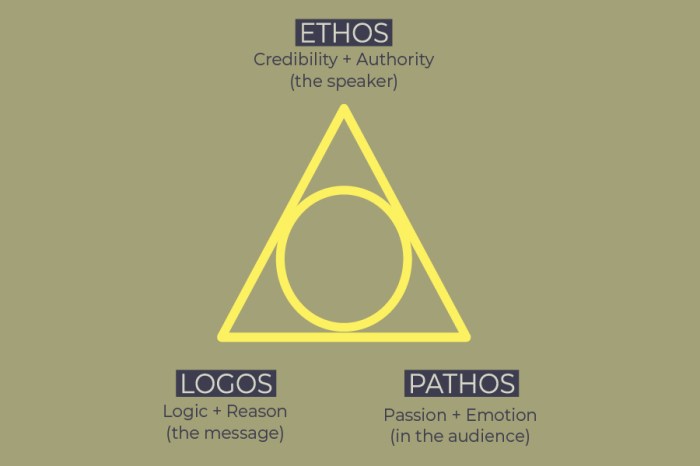Ethos logos and pathos quiz – Embark on a captivating journey with our Ethos, Logos, and Pathos Quiz, where you’ll unravel the secrets of effective persuasion. Discover how these rhetorical devices work together to sway hearts and minds, leaving an unforgettable impact.
In this comprehensive guide, we’ll delve into the depths of each element, exploring real-world examples and unraveling the intricacies of establishing credibility, crafting logical arguments, and evoking powerful emotions.
Ethos
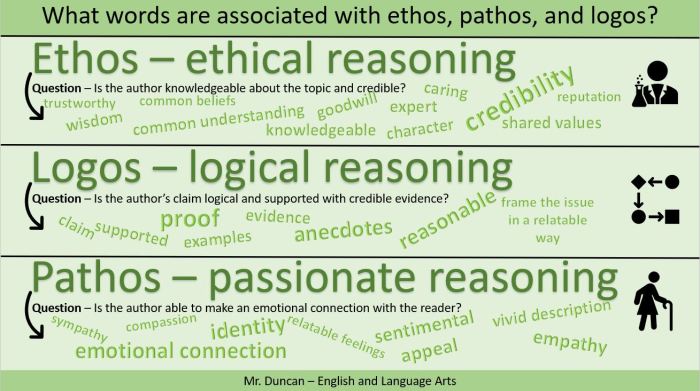
Ethos, derived from the Greek word meaning “character,” refers to the credibility and trustworthiness of a speaker or writer. It is one of the three pillars of persuasion, along with logos (logic) and pathos (emotion).
Ethos plays a crucial role in persuasion by establishing the speaker’s authority, expertise, and trustworthiness. When an audience perceives the speaker as credible and knowledgeable, they are more likely to be persuaded by their message.
Establishing Credibility and Trust
Establishing credibility and trust is essential for effective persuasion. Here are some ways to do so:
- Expertise:Demonstrate your knowledge and experience in the subject matter.
- Experience:Share relevant personal experiences that add credibility to your message.
- Endorsements:Obtain endorsements from respected individuals or organizations.
- Transparency:Be open and honest about your biases and limitations.
- Consistency:Maintain consistency between your words and actions.
Logos: Ethos Logos And Pathos Quiz

Logos, one of the three pillars of persuasion, harnesses the power of logic and reason to convince audiences. It relies on evidence, facts, and sound arguments to appeal to the intellect and build credibility.
In the realm of advertising, logos often takes the form of statistics, scientific studies, or expert testimonials. For instance, a toothpaste advertisement might cite clinical trials proving its effectiveness in reducing cavities. In political debates, candidates may present data on economic growth or social welfare to support their claims.
The Importance of Logical Arguments and Evidence
Using logical arguments and evidence is crucial for effective persuasion through logos. These elements establish the credibility and validity of the message, making it more likely to be accepted by the audience. When arguments are supported by evidence, they become more convincing and persuasive.
The ethos, logos, and pathos quiz is a great way to test your understanding of persuasive techniques. If you’re interested in learning more about how to spot manipulation, I recommend taking the are you a manipulator quiz . This quiz will help you identify the different types of manipulation and how to avoid falling prey to them.
Once you’ve taken the quiz, you can come back to the ethos, logos, and pathos quiz to see how your understanding has improved.
For example, a health campaign promoting the benefits of regular exercise would be more effective if it included statistics on reduced risk of chronic diseases or increased life expectancy. By providing tangible evidence, the campaign strengthens its message and makes it more persuasive.
Pathos
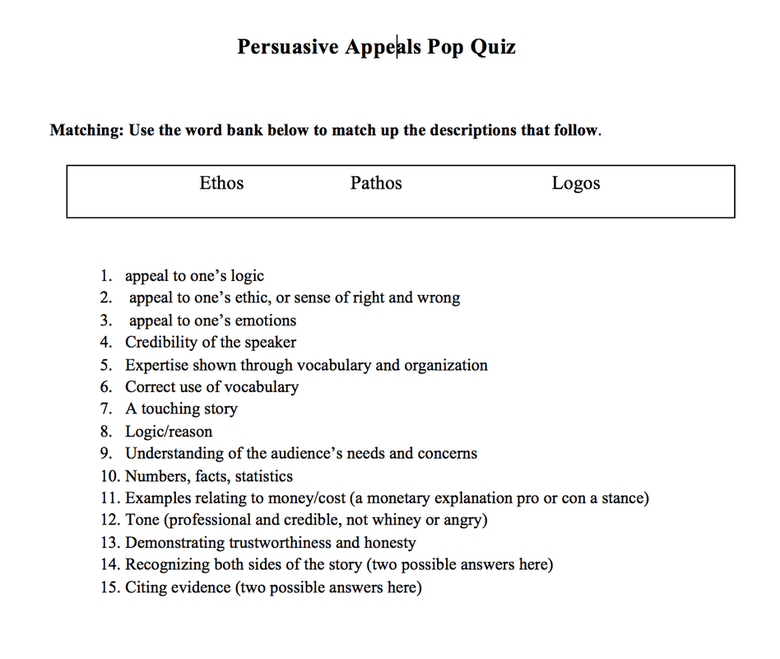
Pathos is a persuasive technique that appeals to the emotions and values of an audience. It aims to create an emotional connection between the speaker and the audience, thereby influencing their beliefs and actions.
Pathos is often used in combination with ethos and logos. Ethos establishes credibility, logos provides logical reasoning, and pathos evokes emotions. By using all three elements, speakers can create a persuasive message that is both credible, logical, and emotionally engaging.
Examples of Pathos
Pathos can be used in a variety of real-world contexts, including:
- Advertising: Advertisers often use pathos to create emotional connections with consumers and persuade them to purchase products.
- Politics: Politicians use pathos to connect with voters and gain their support.
- Public speaking: Speakers use pathos to engage their audience and persuade them to take action.
Importance of Evoking Emotions
Evoking emotions is an important part of persuasion. When people are emotionally engaged, they are more likely to be receptive to new ideas and perspectives. Pathos can be used to create a sense of urgency, fear, anger, or joy, depending on the desired outcome.
By connecting with the audience on an emotional level, speakers can create a persuasive message that is both memorable and effective.
Ethos, Logos, Pathos in Combination
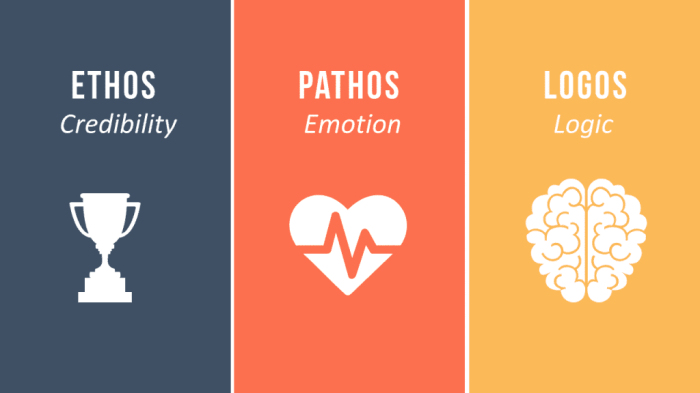
Ethos, logos, and pathos are the three pillars of effective persuasion. By combining these elements, you can create messages that are both credible, logical, and emotionally resonant.
When used together, ethos, logos, and pathos can create a powerful synergy that can persuade even the most skeptical audience. For example, a doctor who uses their medical expertise (ethos) to explain the benefits of a new treatment (logos) while also appealing to the patient’s desire to feel better (pathos) is likely to be more successful in persuading the patient to try the treatment than a doctor who relies on only one or two of these elements.
Importance of Balance, Ethos logos and pathos quiz
It is important to note that the use of ethos, logos, and pathos should be balanced. Too much of one element can be off-putting or even counterproductive. For example, a message that is overly reliant on ethos may come across as arrogant or self-serving, while a message that is overly reliant on pathos may be seen as manipulative or emotional.
Quiz on Ethos, Logos, Pathos
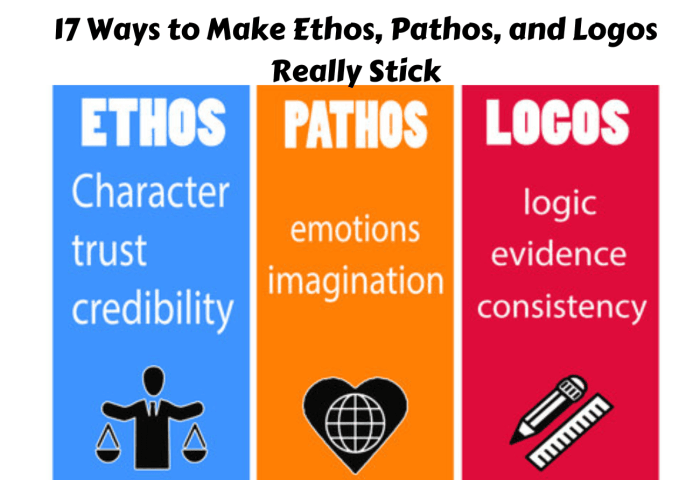
Ethos
This section tests the understanding of ethos, the ethical appeal used to establish credibility and trustworthiness.
- Identify examples of ethos in the following statement: “As a doctor with over 20 years of experience, I recommend this medication for your condition.”
- Explain how ethos can be used to persuade an audience.
Logos
This section tests the understanding of logos, the logical appeal used to present facts and evidence.
- Identify examples of logos in the following statement: “According to a recent study published in a reputable medical journal, this treatment has shown a 75% success rate.”
- Discuss the importance of providing evidence to support claims in a persuasive argument.
Pathos
This section tests the understanding of pathos, the emotional appeal used to evoke feelings and connect with the audience.
- Identify examples of pathos in the following statement: “Imagine the joy of being able to play with your children again after recovering from this surgery.”
- Explain how pathos can be used to make an argument more persuasive.
FAQ Explained
What is the difference between ethos, logos, and pathos?
Ethos refers to the speaker’s credibility and trustworthiness, logos to logical arguments and evidence, and pathos to emotional appeals.
How can I use ethos, logos, and pathos effectively?
Balance the use of all three elements to create persuasive messages that resonate with your audience on an intellectual, emotional, and ethical level.
